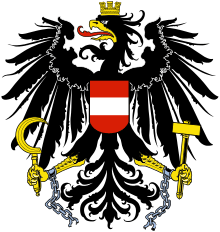Carinthian state and municipal elections, 2009
 |
| This article is part of a series on the politics and government of Austria |
| Constitution |
| Judicial system |
| Foreign relations |
The Carinthian state and municipal elections of 2009 were held in the Austrian state of Carinthia on 1 March 2009. Carinthia is the stronghold of the national conservative Alliance for the Future of Austria, whose founder Jörg Haider died in a car accident on 11 October 2008. He was also the incumbent governor; after his death, he was replaced by Gerhard Dörfler as governor, by Uwe Scheuch as Carinthian BZÖ leader and by his close personal friend Stefan Petzner as national BZÖ leader. The election is likely to see a strong contest between the SPÖ and the BZÖ over the post of governor, while the other Austrian parties (the ÖVP, the FPÖ and the Greens) play only a minor role in Carinthian politics.[1]
An OGM poll solicited by the BZÖ in late 2008 saw the BZÖ leading with 42%, the SPÖ with 29%, the ÖVP at 12%, the Greens at 10% and the FPÖ at 5%; a SORA poll for the Kleine Zeitung in December 2008 saw a much closer race, with the BZÖ at 41% (down from 44% in April), the SPÖ at 38% (up from 33% in April), the ÖVP at 11%, the Greens at 6% and the FPÖ at 2%.[2] A poll by Integral for Kurier in early January 2009 saw the BZÖ at 42%, the SPÖ at 34%, ÖVP at 12%, the Greens at 7% and the FPÖ at 5%.[3] A poll by the Humaninstitut for Die Presse saw 27% for the SPÖ, 25% for the BZÖ and a quarter of voters undecided.[4]
Former deputy mayor of Klagenfurt Mario Canori was announced as the FPÖ's leading candidate on 22 December 2008, surprising many, as he had been a BZÖ member until that very day.[5] The Greens stated that their goal was to increase their share of the vote and gain a third seat.[6]
Following Dörfler's accusations against Canori, in which he claimed that Canori had received €200,000 for becoming the FPÖ leading candidate, Scheuch and Strutz distanced themselves from Dörfler, increasing speculation about a further split within the BZÖ.[7]
The following parties filed to stand in the election:
- Alliance for the Future of Austria, under the name "The Freedom-minded in Carinthia – Jörg Haider's List, BZÖ", despite the fact that the party's founder died in 2008[8]
- Social Democratic Party of Austria
- Austrian People's Party
- The Greens – The Green Alternative
- Freedom Party of Austria
- Communist Party of Austria
- Only in Klagenfurt:
- List Strong
- Gaddafi Party (of the Egyptian-born Ahmed El Mesallamy, who wants to increase Carinthian business relations with the Arab world; Haider was known for his controversial encounters with Saddam Hussein and Muammar al-Gaddafi)[9]
The election saw the BZÖ win even more votes than under Haider, mostly due to nostalgic apotheosis of his personality; the SPÖ lost greatly, the ÖVP gained a bit, the Greens lost slightly and had to hope for the final result including absentee votes to see whether they had even made it into the Landtag, and the FPÖ failed to enter it.[10] With parts of the absentee vote counted, the Greens made it into the Landtag, keeping their two seats.[11]
| Party | Votes in % | Seats | |
|---|---|---|---|
| Alliance for the Future of Austria (BZÖ) | 44.9% | 17 | |
| Social Democratic Party of Austria (SPÖ) | 28.8% | 11 | |
| Austrian People's Party (ÖVP) | 16.8% | 6 | |
| The Greens – The Green Alternative (Grüne) | 5.1% | 2 | |
| Freedom Party of Austria (FPÖ) | 3.8% | 0 | |
References
- ↑ http://derstandard.at/?url=/?id=1226396929073
- ↑ http://derstandard.at/?url=/?id=1229796858592
- ↑ http://www.kurier.at/nachrichten/286118.php
- ↑ http://diepresse.com/home/politik/innenpolitik/442981/index.do?_vl_backlink=/home/index.do
- ↑ http://kaernten.orf.at/stories/330592/
- ↑ http://derstandard.at/?url=/?id=1229975068393
- ↑ http://www.oe24.at/oesterreich/politik/Orange_saegen_an_Doerflers_Sessel_413424.ece
- ↑ http://kaernten.orf.at/stories/337225/
- ↑ http://oe1.orf.at/inforadio/101548.html?filter=3
- ↑ http://derstandard.at/?id=1234508290669
- ↑ "Archived copy". Archived from the original on 2011-06-05. Retrieved 2009-03-03.